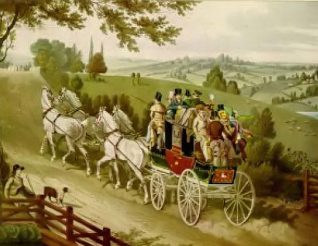Early carriers

Please note that this text is an extract from a reference work written in 1990. As a result, some of the content may not reflect recent research, changes and events.
a) EARLY CARRIERS: The first record of a regular carrier to Brighton dates from 1681 when Thomas Blewman conveyed goods and passengers from London to Lewes, Newhaven, Brighton and Shoreham. By 1732 there was a regular coach service from Brighton to London, and in 1745 the Flying Machine was leaving the Old Ship at 5.30 a.m. and reaching London the same day. As the number of visitors increased so did the coaching traffic, then the only means of long-distance transport, and the first separate coaching office (i.e. not based at an inn) was opened at 1 North Street in about 1794.
The main route from London was via Henfield, Saddlescombe and along the Dyke Road into North Street, but this changed in 1810 when the new turnpike opened between Pyecombe and Bolney. Journey times were eight hours or more with stops made at almost every inn en route, and passengers had to walk up some of the steeper hills. Those who could not afford such luxury were carried in open carriers’ wagons taking up to two days.
b) IMPROVEMENTS IN SPEED: By June 1811 there were twenty-eight coaches daily between London and Brighton taking six hours, with the first coach journey from London to Brighton and back in the same day coming in 1813. In 1815 there were fifty-two coaches daily but, as rival companies attempted to better journey times, the authorities intervened to restrict the continuous galloping of horses following a week in 1816 in which fifteen horses died.
The ‘golden age’ of coaching lasted from 1820 until the arrival of the railway from London in 1841, with coaches leaving from the six offices in Castle Square for London, Portsmouth, Southampton, Tunbridge Wells, Maidstone, Oxford, Windsor and other Sussex destinations. Times were improved by the macadamisation of roads, by the use of lighter coaches and shorter stages, although the higher speeds resulted in many accidents. The improvement in times also gave rise to the first London commuters, stock-jobbers being recorded in 1823 as spending two-and-a-half hours in the city daily {2}. In 1832 steam coaches were introduced but were never a serious rival to horse power. On 25 October 1833 a record 480 visitors arrived in the town by coach, and in February 1834 the all-time speed record was set when the Criterion brought the King’s speech to Brighton in just 3 hours 40 minutes.
c) COMING OF THE RAILWAY: The rapid demise of horse-coaching came in 1841 when the railway from London opened, such that by 1843 only one coach was still operating to the City and none at all after 1845. A few years later the Age started running again until 1862 as a romantic alternative and a coaching revival followed from 1867 until 1887, but the last coach to run regularly was the Vigilant from 1901 until 1905.
d) MOTOR-COACHES: The first regular London-to-Brighton motor-coach, the Vanguard, was run by the London Motor Omnibus Company from August 1905 {2}. The number of coaches coming to the town rose rapidly, necessitating restrictions along Madeira Drive by 1927, and in August 1928 a record 623 coaches arrived in the town in one day. There was a proposal in 1929 to turn the Level into a coach-park but this was fortunately rejected. The post-war peak was reached in June 1952 when 530 coaches arrived in one day. {164}
Any numerical cross-references in the text above refer to resources in the Sources and Bibliography section of the Encyclopaedia of Brighton by Tim Carder.
The following resource(s) is quoted as a general source for the information above: {2,15,69,70}




No Comments
Add a comment about this page